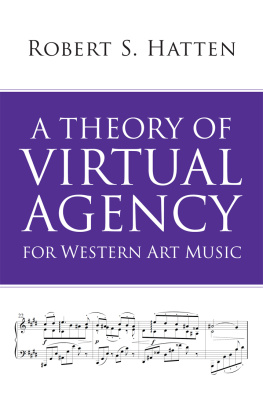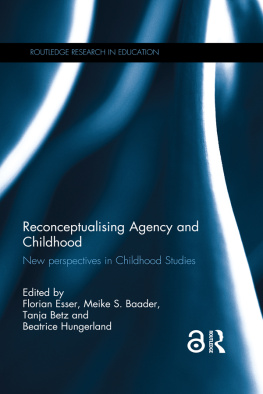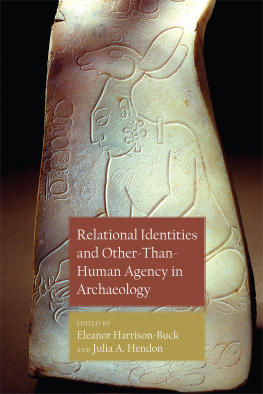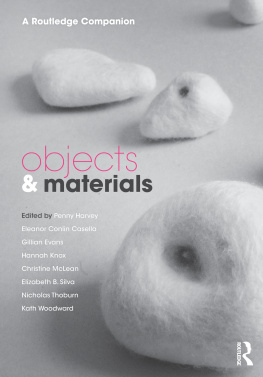Distributed Objects
DISTRIBUTED OBJECTS
Meaning and Mattering after Alfred Gell
Edited by Liana Chua
and
Mark Elliott

First published in 2013 by
Berghahn Books
www.berghahnbooks.com
2013, 2015 Liana Chua and Mark Elliott
First paperback edition published in 2015
All rights reserved. Except for the quotation of short passages for the purposes of criticism and review, no part of this book may be reproduced in any form or by any means, electronic or mechanical, including photocopying, recording, or any information storage and retrieval system now known or to be invented, without written permission of the publisher.
Parts of were previously published in Gell, Alfred. The Anthropology of Time (Oxford: Berg, 1992). Reproduced with the permission of Bloomsbury Publishing Plc.
Library of Congress Cataloging-in-Publication Data
Distributed objects : meaning and mattering after Alfred Gell / edited by
Liana Chua and Mark Elliott.
p. cm.
Includes bibliographical references and index.
ISBN 978-0-85745-744-8 (hardback : alk. paper) -- ISBN 978-1-78238-913-2 (paperback : alk. paper) -- ISBN 978-0-85745-743-1 (ebook)
1. Art and anthropology. 2.
Art and society. 3. Creative ability. 4. Gell, Alfred. I. Chua, Liana. II. Elliott, Mark.
N72.A56D57 2013
701.03--dc23
2012017051
British Library Cataloguing in Publication Data
A catalogue record for this book is available from the British Library.
Printed on acid-free paper
ISBN 978-0-85745-744-8 hardback
ISBN 978-1-78238-913-2 paperback
ISBN 978-0-85745-743-1 ebook
CONTENTS
Liana Chua and Mark Elliott
Susanne Kchler
Chris Gosden
Jeremy Tanner
Alfred Gell
Simon Dell
Georgina Born
Warren Boutcher
Eric Hirsch
Nicholas Thomas
LIST OF ILLUSTRATIONS
Alfred Gell, n.d. Worshippers before an Idol.
Alfred Gell, n.d. Preliminary sketch of the art nexus.
Bronze Age socketed axes from the late Bronze Age site at Tower Hill, Oxfordshire.
The Grotesque torc from Snettisham.
The Sutton scabbard.
Gallo-Belgic C coin abstraction.
Tomb of Mausolus of Caria, Halicarnassus, c. 350 BC. Reconstruction by Peter Jackson.
The Tomb Mound of the First Emperor, erected c. 221210 BC.
The Terracotta Army. Pit 1. 221210 BC.
Plan of Changtaiguan tomb M1, Xinyang, Henan Province. Fifth to fourth century BC.
Early Chinese funerary figurines.
From Mashan, Jiangling, Hubei. Fourth century BC.
Wooden figure of a warrior, from a fourth century BC Chu tomb.
From Bao Shan, Hubei.
Terracotta armoured infantry man, from Pit 1. 221210 BC.
Characters identifying responsible producers, on the back of a figure.
Slabs 1014 and 1021 from the Amazonomachy Frieze of the Mausoleum of Halicarnassus, c. 350 BC.
Duchamp, Marcel (18871968). Nude Descending a Staircase, No. 2, oil on canvas, 1912.
Duchamp, Marcel (18871968). Network of Stoppages, 1914.
Alfred Gell, model of Husserls internal time-consciousness.
Alfred Gell, The artists oeuvre as a temporal-relational diagram.
Marcel Duchamp, Pharmacy, from View, New York, magazine containing a rectified readymade after the original of 1914.
Marcel Duchamp, The Box in a Valise 19351941 (leather-covered case containing miniature replicas and photographs).
G. Whitney, A Choice of Emblemes (Leiden: C. Plantin, 1586), sig. R2r (Scripta manent).
Body paintings on initiates at a Yolngu circumcision ceremony. The boys lie still for several hours while the designs are painted on their chests. They are surrounded by members of clans of their own moiety who sing songs that relate to the paintings that are being produced, referring to the journeys of the ancestral beings manifest in the images.
The Family of Felipe IV, or Las Meninas, by Diego Rodrguez de Silva y Velzquez (1656).
Esa u kum women dancing disco kere at Hausline village.
Migu performing kere in conventional manner at Hausline village.
PREFACE
This volume is both a protention and a retention: a nodal point in a series of conversations between Alfred Gell and a collection of scholars who have in various ways drawn inspiration from, critiqued and expanded his seminal anthropological theory of art, Art and Agency (1998). Its origins lie in the Art and Agency: Ten Years On symposium, which we convened in Cambridge on 15 November 2008 to mark the tenth anniversary of the books posthumous publication. We are grateful to the Centre for Research in the Arts, Social Sciences and Humanities (CRASSH) for sponsoring and organizing the symposium, to the University of Cambridge Museum of Archaeology and Anthropology for hosting the post-symposium reception, to all the speakers whose papers are now collected in this volume, and to the guest chairs and discussants who held the panels together so nicely on the day: Marilyn Strathern, Martin Holbraad, Graeme Were and Stephen Hugh-Jones. Fittingly, the speakers and their papers were given a pretty serious (but good-natured) grilling by an audience that remained engaged, incisive and very generous throughout.
In preparing the present volume, we have added a few contributions to the symposiums original line-up. Chief among these is The Network of Standard Stoppages, a hitherto unpublished essay written around 1985 by Gell himself, which his wife Simeran found amidst his files and boxes. With some luck, we managed to assemble all the relevant pages (though not, sadly, all the accompanying diagrams) to form the full document, which is published here for the first time. An engaging piece centred on the work of Marcel Duchamp, it may be read as a precursor to some of Gells most innovative arguments on time, change and creativity towards the end of Art and Agency. Alternatively, it could simply be taken as a recently rediscovered component of Gells oeuvre; an insight into an extraordinarily fertile mind that was engaging in serious cross-disciplinary study well before the concept became fashionable. NSS, as we now call it, is followed by a short commentary by Simon Dell, who provides an art-historical perspective on its content. Finally, the book closes with an epilogue by Nicholas Thomas one of Gells closest collaborators, who was among those responsible for preparing Art and Agency for publication after his death.
From the time we began work on this project, we enjoyed the blessing and unwavering support of Simeran and Rohan Gell. We are particularly indebted to Simeran for letting us into her (and her late husbands) life, giving us full access to Gells vast collection of papers, fieldnotes, lecture notes, and most intriguingly, drawings and diagrams which he made in both his childhood and later years, which reveal the intense visuality of his thought. (Some of these ended up in Art and Agency; two have been reproduced here.) For all this and more, we are immensely grateful.
Liana Chua and Mark Elliott
INTRODUCTION
ADVENTURES IN THE ART NEXUS
Liana Chua and Mark Elliott
Visceral Reactions
Participants at the symposium,
Next page







